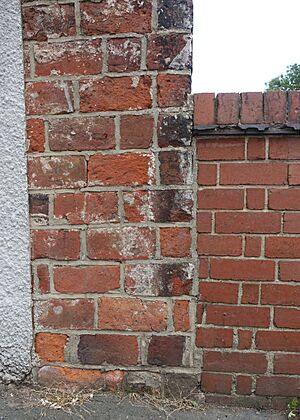Brick tax facts for kids
The brick tax was a special tax on bricks in Great Britain. It started in 1784, during the time of King George III. This tax was put in place to help pay for the expensive wars happening in the American Colonies. When it first began, the tax was 2 shillings and 6 pence for every thousand bricks. The brick tax was finally removed in 1850.
Contents
Why was the brick tax suggested?
The idea for a brick tax first came up in 1756. It was suggested by Lord George Lyttelton. Some people thought this tax was unfair. This was because certain parts of Britain mainly used stone for building houses, not bricks. Also, very rich people often built their homes entirely from stone, so the tax wouldn't affect them.
Lord Lyttelton's idea for the brick tax didn't pass. So, he then tried to get a tax on pub owners instead. This new tax was expected to bring in much more money than the brick tax would have.
The brick tax was suggested again in 1778 but was rejected once more.
When did the brick tax finally pass?
The brick tax finally became a law in 1784. This happened because the government needed money to pay for the War of American Independence. Bricks were chosen for the tax because they had become very popular for building in the late 1700s.
How did the brick tax work?
The tax was collected on bricks before they were burned in a kiln. To show that a brick had been taxed, the word 'excise' was put on the mould. This left an imprint on the brick itself.
When the tax started, it was 2 shillings and 6 pence for every thousand bricks. The tax went up to 4 shillings per thousand in 1794. Then, it increased again to 5 shillings in 1797.
How did brick makers try to avoid the tax?
To try and lessen the effect of the tax, brick makers started making their bricks much bigger. For example, a builder named Joseph Wilkes in Measham, Leicestershire, used bricks called Wilkes' gobs. These bricks were about 9.25 inches long, 4.25 inches wide, and 4.25 inches tall.
In 1801, the government noticed this trick. They set a limit on how big a brick mould could be: 10 inches long, 5 inches wide, and 3 inches tall. They also doubled the tax on any bricks that were larger than these new limits. Remember, the finished bricks would be a bit smaller than the mould size because bricks shrink when they are burned.
The brick tax was raised one last time in 1805. It then cost 5 shillings and 10 pence for every thousand bricks.
When was the brick tax removed?
The brick tax was finally removed in 1850. By this time, many people believed it was slowing down new building and industrial growth.
What were the effects of the brick tax?
One big effect of the brick tax was that some smaller brick makers went out of business. They had to sell their bricks to pay the taxes they owed.
The tax also changed how buildings looked. In many areas, people started using more wood for building houses. They also used special wooden boards called weatherboarding or even mathematical tiles. These tiles were designed to look like bricks but were often cheaper because of the tax.
The brick tax made bricks more expensive. This meant that building new homes and paying rent became more costly for everyone.
How did the tax affect other building materials?
Until 1833, the brick tax also applied to tiles and pipes. The tax on pipes meant that many families couldn't afford proper drainage pipes for their homes. This led to lower quality housing. Tiles were taxed based on their size and how much they were decorated. This made people choose plain, cheaper tiles. It slowed down new ideas in architecture and building styles.
After the brick tax was removed in 1850, the quality of bricks used in churches and public buildings improved. Also, buildings made before 1784 and after 1850 often have more decorations and better designs. This shows how the brick tax had limited creativity in building for many years.
See also
- Glass tax
- Hearth tax
- Window tax
- Wallpaper tax


